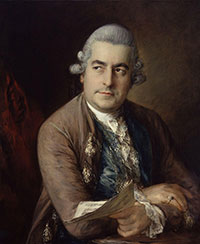 Johann Sebastian Bach is undoubtedly one of the most famous composers in history. His contributions to Lutheran music have made the family name synonymous with that German sacred tradition. Once, when discussing music, my local priest at the time, told me Bach was the only good thing to come out of the Reformation. It made me laugh even though I’m not entirely sure he was joking.
Johann Sebastian Bach is undoubtedly one of the most famous composers in history. His contributions to Lutheran music have made the family name synonymous with that German sacred tradition. Once, when discussing music, my local priest at the time, told me Bach was the only good thing to come out of the Reformation. It made me laugh even though I’m not entirely sure he was joking.
Bach’s religious nature was not separate from his career – it was a critical aspect of who he was. At the top of his sacred compositions, he wrote the initials “J.J.” – an abbreviation of the Latin “Jesu Juva” (“Jesus help”) and at the end, “S.D.G.” for “Soli Deo Gloria” (“To God alone be the glory”).
Bach had many children from his first marriage, which ended with his wife’s death, and many more with his second wife.
Several sons became professional musicians, the most famous being C.P.E. Bach (1714-1788). His youngest surviving son was Johann Christian Bach (1735-1782), affectionately nicknamed among musicians as the “London Bach.” J.C. Bach was born in Leipzig, where he received his musical training under his father’s teaching until the senior Bach’s death in 1750. From there, he moved to Berlin where his older half-brother, C.P.E., was working for Frederick the Great, King of Prussia, who was also a fine musician himself.
When he was 20, J.C. made a life-changing move to Milan, Italy. There he converted to Roman Catholicism, leaving behind his staunchly Lutheran upbringing. His music stemming from this period is primarily written for the Church while he was employed as an organist at the Milan Cathedral. His time in Italy also impacted a genre in which his famous father never composed: the Italian opera.
J.C. then moved to London and took on the more English-sounding name of John, eventually becoming music master to Queen Charlotte. Today we know of her as the namesake of Charlotte – the seat of our diocese.
London was one of the first European cities to offer public concerts, and J.C. performed one of the first solo concerts on the keyboard instrument becoming fashionable at the time: the pianoforte (or piano, as it is called today).
It was in London that another equally famous composer, Wolfgang Amadeus Mozart, met J.C., while on his extensive travels as a child musical prodigy. During their visits together, they reportedly played harpsichord duets. Mozart even arranged some of J.C.’s music from solo sonatas into piano concerti (music for piano and orchestra).
Like Mozart, J.C. lived a relatively short life, dying in poverty in 1782 after a long illness. Yet along with his famous family name, his musical legacy lives on.
— Christina L. Reitz. Portrait of Johann Christian Bach, painted in London by Thomas Gainsborough, 1776.
Listen online
While J.C. Bach’s musical influence was primarily on instrumental works, his gift of lyricism is on full display in his choral works, as seen in the soprano solo in the opening to his “Magnificat in C major.” Listen to a performance by the Süddeutscher Kammerchor and the Concerto Köln, directed by Gerhard Jenemann.
‘Can you drink the cup?’
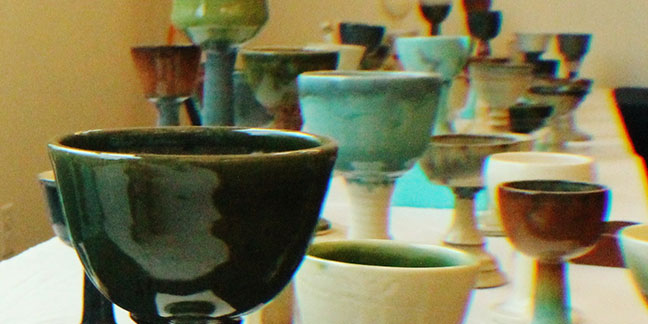 KERNERSVILLE — A love of clay and his Catholic faith served as inspiration for local artist Peter Strafaci to create 100 unique, hand-thrown pottery chalices.
KERNERSVILLE — A love of clay and his Catholic faith served as inspiration for local artist Peter Strafaci to create 100 unique, hand-thrown pottery chalices.
His 2016 collection, the “One Hundred Chalices Exhibit,” has been displayed at parishes, Christian churches and faith-based conferences.
The chalices feature variations of colored glazes, and no two are the same. Chalices hold a special place in Christian worship, as Jesus offered the chalice to His disciples in the upper room during the Last Supper, just hours before His crucifixion.
Strafaci offers a presentation – “Can You Drink the Cup?” – for those interested. It is based on both a book he read with the same title by Father Henri Nouwen and on Matthew 20:20-23. In this Scripture passage, Jesus questions the sons of Zebedee: “Can you drink the cup that I am going to drink?”
“The cup that Jesus speaks about is neither a symbol of victory nor a symbol of death,” Strafaci explains. “It is a symbol of life, filled with sorrows and joys that we can hold, lift and drink as a blessing and a way to salvation.”
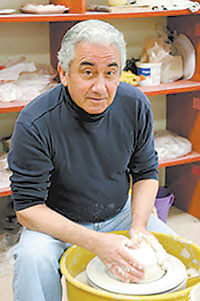 Artist Peter Strafaci throws some pottery at his studio in this undated photo. (Photo provided)Strafaci says the chalices took about 10 months to create. He threw the stems and cups separately, in batches of 12 or 13 at a time. “They were created with very little mishap,” he recalls. “I sensed the Lord blessed this work, as I have been working with pottery for over 50 years.”
Artist Peter Strafaci throws some pottery at his studio in this undated photo. (Photo provided)Strafaci says the chalices took about 10 months to create. He threw the stems and cups separately, in batches of 12 or 13 at a time. “They were created with very little mishap,” he recalls. “I sensed the Lord blessed this work, as I have been working with pottery for over 50 years.”
He estimates it took at least 40 minutes to create each chalice on the potter’s wheel and additional time to glaze each one before firing it in the kiln.
Strafaci admits he did have one providential mishap when he was transporting the exhibit in 2016 that has reaped unforeseen spiritual benefits for his audience. A box of chalices was damaged, and four of the chalices used in the exhibit were broken.
“It dawned on me to take the four broken chalices and make them still part of the 100. This represents the brokenness in each of us,” he explains. “I’ve kept those four chalices to use them to illustrate this point.”
Strafaci says that for smaller groups he begins his presentation by inviting participants to select one chalice to take back to their seat to hold during the presentation for contemplation.
Reactions to the exhibit over the years have been very positive. Mary Martha Douglas, Women’s Bible study coordinator of St. Leo Church in Winston-Salem, helped bring the exhibit to the parish last February.
“I found your talk to be thought provoking, reflective, healing, comforting, inspiring and grounded in Scripture,” she wrote to Strafaci after his presentation.
“Ultimately, you left us with a message of hope and peace for which we are most grateful.”
Now that parishes are resuming normal activities in the wake of the pandemic, Strafaci hopes to share the exhibit with more people across the diocese.
“I’m not there to sell my pottery,” he emphasizes. “I just want to share the exhibit and encourage them with my talk if requested.”
— SueAnn Howell
 Host the exhibit
Host the exhibit
If your parish, group or ministry would like to host the “One Hundred Chalices Exhibit” (with or without the presentation), contact Peter Strafaci at This email address is being protected from spambots. You need JavaScript enabled to view it. or 336-402-8639.
Visit www.peterstrafaci.blogspot.com to learn more about his work.


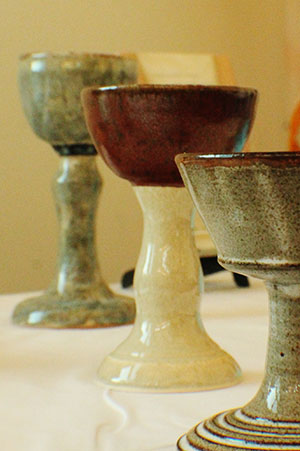
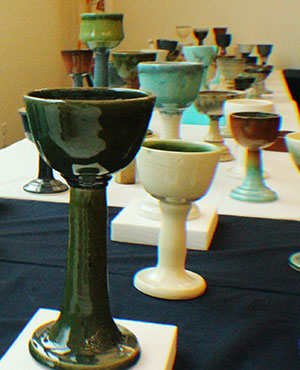 Host the exhibit
Host the exhibit